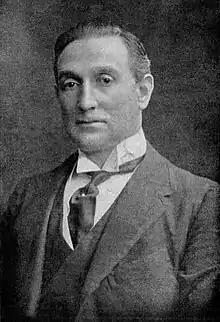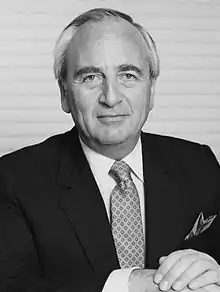List of British Jewish nobility and gentry
The British nobility consists of two sometimes overlapping entities, the peerage and the gentry. The peerage is a legal system of largely hereditary titles, granted by the Sovereign. Under this system, only the senior family member bears a substantive title (duke, marquess, earl, viscount, baron). The gentry are untitled members of the upper classes, however, exceptions include baronets, knights, Scottish barons and lairds.
The history of the Jews in Britain goes back to the reign of William I. The first written record of Jewish settlement in England dates from 1070, although Jews may have lived there since Roman times.[1] The Jewish presence continued until King Edward I's Edict of Expulsion in 1290. After the expulsion, there was no Jewish community, apart from individuals who practised Judaism secretly, until the rule of Oliver Cromwell. While Cromwell never officially readmitted Jews to Britain, a small colony of Sephardic Jews living in London was identified in 1656 and allowed to remain. The Jewish Naturalisation Act of 1753, an attempt to legalise the Jewish presence in Britain, remained in force for only a few months. Historians commonly date Jewish Emancipation to either 1829 or 1858 when Jews were finally allowed to sit in Parliament. The first Jewish knight was Sir Solomon de Medina, knighted in 1700, with no further Jews being knighted until 1837, when Queen Victoria knighted Moses Haim Montefiore; four years later, Isaac Lyon Goldsmid was made a baronet, the first Jew to receive a hereditary title. In 1885 Nathan Mayer Rothschild, 1st Baron Rothschild, became the first Jew to receive an hereditary peerage.
Peerages
Marquessates
Earldoms
- Earl of Beaconsfield (extinct)
- Benjamin Disraeli, 1st Earl of Beaconsfield (converted out)
- Earl of Rosebery and Midlothian
- Harry Primrose, 6th Earl of Rosebery, 2nd Earl of Midlothian (Jewish mother)
Viscountcies
- Viscount Burnham (extinct)
- Viscount Bearsted[3]
- Marcus Samuel, 1st Viscount Bearsted
- Walter Samuel, 2nd Viscount Bearsted
- Marcus Samuel, 3rd Viscount Bearsted
- Peter Samuel, 4th Viscount Bearsted
- Nicholas Alan Samuel, 5th Viscount Bearsted
- Viscount Samuel[4]
Extant
- Baron Rothschild[5]
- Baron Burnham
- Edward Levy-Lawson, 1st Baron Burnham
- Harry Levy-Lawson, 2nd Baron Burnham, created Viscount Burnham
- William Arnold Webster Levy-Lawson, 3rd Baron Burnham
- Edward Lawson, 4th Baron Burnham
- William Edward Harry Lawson, 5th Baron Burnham
- Hugh Lawson, 6th Baron Burnham
- Harry Frederick Alan Lawson, 7th Baron Burnham
- Baron Swaythling[6]
- Samuel Montagu, 1st Baron Swaythling
- Louis Montagu, 2nd Baron Swaythling
- Stuart Albert Montagu, 3rd Baron Swaythling
- David Montagu, 4th Baron Swaythling
- Charles Montagu, 5th Baron Swaythling
- Baron Mancroft[7]
- Baron Nathan
- Harry Nathan, 1st Baron Nathan
- Roger Nathan, 2nd Baron Nathan
- Rupert Harry Bernard Nathan, 3rd Baron Nathan
- Baron Silkin[8]
- Baron Marks of Broughton
- Simon Marks, 1st Baron Marks of Broughton
- Michael Marks, 2nd Baron Marks of Broughton
- Simon Richard Marks, 3rd Baron Marks of Broughton
Extinct
- Baron Eardley
- Sampson Eardley, 1st Baron Eardley (Jewish father)
- Baron Wandsworth[9]
- Baron Pirbright
- Baron Michelham
- Herbert Stern, 1st Baron Michelham
- Herman Alfred Stern, 2nd Baron Michelham
- Baron Jessel
- Baron Duveen[10]
- Baron Melchett
- Baron Hore-Belisha
- Baron Conesford
- Baron Cohen of Birkenhead[11]
Life peerages
- David Alliance, Baron Alliance
- Alexander Bernstein, Baron Bernstein of Craigweil
- Alma Birk, Baroness Birk[12]
- Leon Brittan, Baron Brittan of Spennithorne
- Andrew Feldman, Baron Feldman of Elstree
- David Freud, Baron Freud
- Anna Gaitskell, Baroness Gaitskell
- Robert Gavron, Baron Gavron
- Peter Goldsmith, Baron Goldsmith
- Arnold Goodman, Baron Goodman
- Anthony Grabiner, Baron Grabiner
- Susan Greenfield, Baroness Greenfield
- Michael Howard, Baron Howard of Lympne
- Sydney Jacobson, Baron Jacobson
- Immanuel Jakobovits, Baron Jakobovits[13]
- Lawrence Kadoorie, Baron Kadoorie[14]
- Nigel Lawson, Baron Lawson of Blaby
- Michael Levy, Baron Levy
- Peter Mandelson, Baron Mandelson (Jewish father)
- Yehudi Menuhin, Baron Menuhin
- Claus Moser, Baron Moser[15]
- David Pannick, Baron Pannick[16]
- Maurice Peston, Baron Peston of Mile End
- Beatrice Plummer, Baroness Plummer
- Jonathan Sacks, Baron Sacks
- Cyril Salmon, Baron Salmon[17]
- James Sassoon, Baron Sassoon
- Samuel Segal, Baron Segal
- Beatrice Serota, Baroness Serota
- Emanuel Shinwell, Baron Shinwell
- Israel Sieff, Baron Sieff
- Marcus Sieff, Baron Sieff of Brimpton
- Samuel Silkin, Baron Silkin of Dulwich
- Alan Sugar, Baron Sugar
- David Triesman, Baron Triesman
- Leslie Turnberg, Baron Turnberg
- Robert Winston, Baron Winston
- David Wolfson, Baron Wolfson of Sunningdale
- Leonard Wolfson, Baron Wolfson[18]
- Simon Wolfson, Baron Wolfson of Apsley Guise
- Harry Woolf, Baron Woolf
- David Young, Baron Young of Graffham
- William Tobin, Baron Tobin of Syreford
Gentry
Extant
- Rothschild baronets of Tring Park[5]
- Tuck baronets of Park Crescent[19]
- Sir Adolph Tuck, 1st Baronet
- Sir William Reginald Tuck, 2nd Baronet
- Sir Bruce Adolph Reginald Tuck, 3rd Baronet
- Magnus baronets of Tangley Hill[20]
- Cassel baronets of Lincoln's Inn
- Sir Felix Maximilian Schoenbrunn Cassel, 1st Baronet
- Sir Francis Edward Cassel, 2nd Baronet
- Sir Harold Felix Cassel, 3rd Baronet
- Sir Timothy Felix Harold Cassel, 4th Baronet
- Joseph baronets of Portsoken
- Sir Samuel Joseph, 1st Baronet
- Sir Keith Joseph, 2nd Baronet, created a life peer in 1987
Extinct
- Goldsmid baronets of St John's Lodge
- Montefiore baronets of East Cliff Lodge[21]
- Goldsmid-Stern-Salomons baronets of Broom Hill
- Montefiore baronets of Worth Park[22]
- Sir Francis Abraham Montefiore, 1st Baronet
- Sassoon baronets of Kensington-gore and of Eastern-terrace[23]
- Sassoon baronets of Bombay[24]
- Oppenheimer baronets of Stoke Poges
- Sir Bernard Oppenheimer, 1st Baronet
- Sir Michael Oppenheimer, 2nd Baronet
- Sir Michael Bernard Grenville Oppenheimer, 3rd Baronet
- Beit baronets of Tewin Water
- D'Avigdor-Goldsmid baronets of Somerhill[25]
- Wolfson baronets of St. Marylebone[18]
- Sir Isaac Wolfson, 1st Baronet
- Sir Leonard Wolfson, 2nd Baronet, created a life peer in 1985
Scottish feudal baronies
- Barony of Craigie
- Rabbi Robert Owen Thomas
Knighthoods
- Sir Ken Adam
- Sir Victor Blank
- Sir Ernest Cassel (converted out)
- Sir Charles Clore
- Sir Solomon de Medina (knighted 1700)[21]
- Sir Clement Freud (converted out)
- Sir Samuel Gluckstein
- Sir James Goldsmith (Jewish father)
- Sir Israel Gollancz
- Sir Philip Green
- Sir Basil Henriques
- Sir George Henschel
- Sir George Jessel
- Sir Ellis Kadoorie
- Sir Elly Kadoorie[14]
- Sir Horace Kadoorie[14]
- Sir Michael Kadoorie
- Sir Ralph Kohn
- Sir Ivan Lawrence
- Sir Oliver Letwin
- Sir Joseph Lyons
- Sir Alan Mocatta
- Sir Francis Palgrave
- Sir Michael Moritz[26]
- Sir Stirling Moss (paternal grandfather was Jewish)[27]
- Sir Malcolm Rifkind
- Sir Tony Robinson
- Sir Isidore Salmon
- Sir Samuel Isidore Salmon
- Sir Harry Samuel
- Sir Nicholas Serota
- Sir Peter Shaffer
- Sir Henry Slesser (converted out)
- Sir Georg Solti
- Sir Nicholas Winton (converted out)
- Sir Henry Drummond Wolff
References
Citations
- Kessler & Wenborn, p. 443.
- Rubinstein, p. 457.
- Rubinstein, p. 854.
- Rubinstein, p. 293.
- Rubinstein, pp. 825–826.
- Rubinstein, p. 688.
- Rubinstein, p. 639.
- Rubinstein, p. 913.
- Rubenstein, p. 959.
- Rubinstein, p. 457.
- Rubinstein, p. 163.
- Labour mourns the death of stalwart Baroness Birk, Herald Scotland.
- Rubinstein, p. 470.
- Rubinstein, p. 498.
- Archived 17 July 2012 at the Wayback Machine
- Jewish Chronicle
- Rubinstein, p. 845.
- Rubinstein, p. 428.
- Jackson, p. 208.
- Rubinstein, p. 634.
- Green, Chapter 5.
- Rubinstein, p. 690.
- "No. 26019". The London Gazette. 31 January 1890. p. 545.
- "No. 28220". The London Gazette. 2 February 1909. p. 826.
- Rubinstein, p. 342.
- "No. 60534". The London Gazette (Supplement). 15 June 2013. p. 25.
- Williams, Richard (12 April 2020). "Sir Stirling Moss obituary". The Guardian. Retrieved 12 April 2020.
Sources
- Kessler, Edward; Wenborn, Neil, eds. (2005). A Dictionary of Jewish-Christian Relations. University of Cambridge Press. ISBN 9780521826921.
- Green, Abigal (2012). "5: Rise, Sir Moses". Moses Montefiore. USA: Harvard University Press. ISBN 0674048806.
- Jackson, B. S., ed. (1979). "Notes". Jewish Law Annual. Leiden, Netherlands. 2.
- "Labour mourns the death of stalwart Baroness Birk". Herald Scotland. 31 December 1996. Retrieved 8 January 2015.
- Rubinstein, William D.; Jolles, Michael; Rubinstein, Hilary L. (2011). The Palgrave Dictionary of Anglo-Jewish History. Palgrave Macmillan. ISBN 9780230304666.


